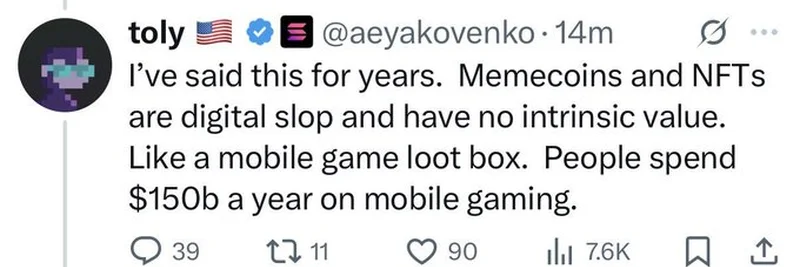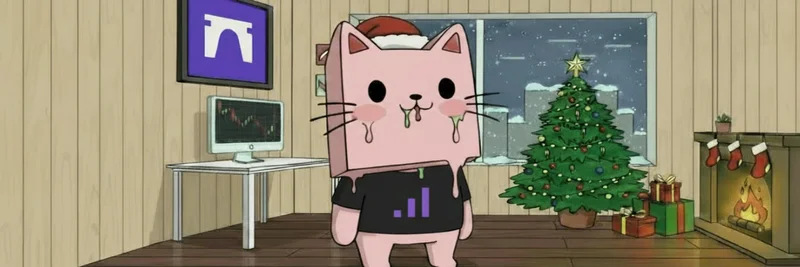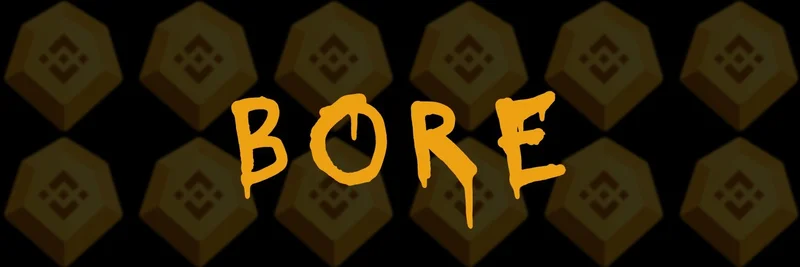The Hot Take: Memecoins and NFTs as Digital Slop
Recently, a tweet from @aeyakovenko, posted on July 27, 2025, has sparked a lively debate in the crypto community. The user, known as "toly," boldly stated, "I've said this for years. Memecoins and NFTs are digital slop and have no intrinsic value. Like a mobile game loot box. People spend $150b a year on mobile gaming." With 7.6K impressions and 90 likes, this opinion has clearly struck a chord—or a nerve—among blockchain enthusiasts.
So, what’s the fuss about? Let’s break it down and explore whether memecoins and NFTs truly lack intrinsic value, and how they stack up against the gaming world’s loot box phenomenon.
What Does "Intrinsic Value" Mean Anyway?
Before we dive into the tweet, let’s clarify a key term. Intrinsic value refers to the inherent worth of an asset based on its fundamental properties—like gold’s use in jewelry or a company’s ability to generate profit. For digital assets like memecoins (think Dogecoin or Shiba Inu) and NFTs (unique digital collectibles), the debate often centers on whether their value comes from utility or just hype.
Toly’s argument hinges on the idea that these assets are more like speculative gambles than meaningful investments. And the loot box comparison? It’s a clever jab, suggesting that people are spending big bucks on randomized digital goodies without guaranteed returns—sound familiar?
Memecoins: Hype or Community Power?
Memecoins have taken the crypto world by storm, often driven by viral trends and social media buzz. Unlike Bitcoin or Ethereum, which aim to solve real-world problems like decentralized finance, memecoins are usually born from jokes or internet memes. Their value often spikes due to community enthusiasm rather than any built-in utility.
But here’s the twist: some argue that this community strength is a form of value. A tight-knit group can push a memecoin’s adoption, creating a self-sustaining ecosystem. Still, when the hype fades, many memecoins crash, leaving investors wondering if they’re just digital slop after all.
NFTs: Art, Identity, or Overhyped Collectibles?
NFTs, or non-fungible tokens, exploded in popularity with projects like CryptoPunks and Bored Ape Yacht Club. They’re unique digital assets, often tied to art or virtual identity, and traded on blockchains like Ethereum or Solana. But do they have intrinsic value? Critics like toly say no, pointing out that their worth depends on what someone else is willing to pay—much like a rare trading card.
On the flip side, NFTs have evolved beyond art. Some are used for gaming perks, virtual land ownership in the metaverse, or even proof of membership in exclusive communities. As the technology matures, their utility might grow, challenging the "no value" narrative.
The Loot Box Parallel: A $150 Billion Industry
Toly’s mention of the $150 billion mobile gaming industry is a striking statistic. Loot boxes—randomized in-game purchases—generate billions annually, despite criticism for mimicking gambling. Players spend money hoping for rare items, but the outcome is uncertain, much like buying a memecoin or NFT.
This comparison suggests that the appeal of memecoins and NFTs might lie in the thrill of the chase rather than any inherent worth. In 2025, with mobile gaming still booming, it’s a fair point to ponder: are we just trading one form of digital excitement for another?
What’s the Verdict?
So, are memecoins and NFTs digital slop with no intrinsic value? It depends on your perspective. If you see value in community, creativity, or future potential, you might argue they have something to offer beyond speculation. But if you’re looking for tangible utility—like a stock’s dividends or a currency’s stability—they might feel more like loot boxes than legitimate assets.
At meme-insider.com, we’re keeping an eye on these trends. As blockchain tech evolves, the line between hype and value might blur further. What do you think? Drop your thoughts in the comments, and let’s keep the conversation going!




